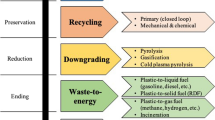Abstract
The most pressing environmental problems of casting production in small-scale foundry sector are gaseous emission and utilization of energy. Promotion of clean technology towards cleaner production has achieved significant improvement. But that technology was not widely accepted due to different barriers. However, incremental innovation with the existing technology got preference. For realization of the scenario, operational performances of cupola and pollution control system were evaluated in 12 units and 15 units, respectively. The study revealed that foundry sector, as a whole, could not ensure proper utilization of the energy and the control of emission. The parameters governing the efficiency of these technologies varied remarkably, which questions its consistency and reliability. This study focused the major barriers towards cleaner production with an aim to define the strategies to overcome the eco-friendly casting production.


Similar content being viewed by others
References
Baldwin VH Jr (1980) Environmental assessment of iron casting EPA-600/2–80-021 (NTIS PB 80–187545). USEPA, Cincinnati
Baldwin VH (1982) Environmental assessment of melting, inoculation and pouring. American Foundrymen’s Society 153:65–72
Cansu FI, Özgür E, Semra I, Naime A, Veysel Y, Seyhan A (2008) Application of multivariate statistical techniques in the assessment of surface water quality in Uluabat Lake, Turkey. Environ Monit Assess 144:269–276
Crabaugh HR, Rose AH, Chass RL (1954) Dust and fumes from gray iron cupolas: how are they controlled in Los Angeles County? Air Repair 4:25–130
Douglas J (1991) Electrifying the foundry fire. EPRI J Oct/Nov:17–23
Dugar SC, Pal P, Bhattacharjee S, Brown M, Jaboyedoff P, Bandopadhyay D (1999) Energy efficiency improvement and pollution reduction in a small scale foundry unit in India e results of a full scale demonstration plant. In: Proceedings of the sixth Asian foundry congress, Kolkata, pp 23–26. Organized by the Institute of Indian Foundrymen. The Institute of Indian Foundrymen, Kolkata, pp 347
Environment Agency (2005) Sampling requirements for stack-emission monitoring. Technical Guidance Note M1, Version-3, October
Humphery JB (1983) Dust control in foundries. Indian Foundry J 28–30
Kelepertsis AE, Karamanou E, Polizoins E (1982) Factor analysis in interpretation of geochemical data. An example from Loadikino Akropotamia–Kilkis area. Min Wealth 18
Mitchell CL (2006) Beyond barriers: examining root causes behind commonly cited cleaner production barriers in Vietnam. J Clean Prod 14:1576–1585
Moors EHM, Mulder KF, Vergragt PJ (2005) Towards cleaner production: barriers and strategies in the base metals producing industry. J Clean Prod 13:657–668
Pal P, Sethi G, Nath A, Swami S (2006) Towards cleaner technologies in small and micro enterprises: a process-based Unit study of foundry industry in India. J Clean Prod 16:1264–1274
Pavitt K (1984) Sectoral patterns of technical change: towards a taxonomy and a theory. Res Policy 13:343–373
Rabah MA (1999) Cost effectiveness of abatement options for emissions control in Egyptian iron foundries. Waste Manage 19:283–292
Rathi AKA (2001) Environment management: some issue and policies. Indian J Environ Health 43:119–127
Rathi AKA (2003) Promotion of cleaner production for industrial pollution abatement in Gujarat (India). J Clean Prod 11:583–590
Roy AC (1996) An integrated approach to environment friendly and energy conservation in foundries. Environmental and waste management in metallurgical laboratory and IZM, Jamshedpur, India, pp 45–51
Scnelle KB, Arnold C (2002) Air pollution control technology handbook. CRC Press, Boca Raton, FL
Toeniskoetter RH, Schafer (1977) Industrial hygiene aspects of the use of sand binders and additives. BCIRA Report 1264
Unnikrishnan S, Hegde DS (2007) Environmental training and cleaner production in Indian industry—a micro-level study. Resour Conserv Recycling 50:427–441
U.S. Environmental Protection Agency (1971) Air pollution aspects of the iron foundry. APTD-0806, Research Triangle Park, NC
U.S. Environmental Protection Agency (2000a) Method-5: determination of particulate matter from stationary sources. 40(60):371–442
U.S. Environmental Protection Agency (2000b) Method-6: determination of sulphur dioxide from stationary Sources. 40(60):581–617
U.S. Environmental Protection Agency (2000c) Method-7: determination of nitrogen oxide from stationary sources. CFR 40(60):645–669
West Bengal Pollution Control Board (1997) Air pollution control technology for iron foundries: a unit study. APC/01/1997
Wijayatunga PDC, Siriwardena K, Fernando WJLS, Shreshtha RM, Attalage RA (2006) Strategies to overcome barriers for cleaner generation technologies in small developing power systems: Sri Lanka Unit study. Energy Convers Manag 47:1179–1191
Acknowledgments
The author expresses his gratitude for the Chairman, Central Pollution Control Board and for the Officer-in-Charge Zonal Office, Central Pollution Control Board, Calcutta for their encouragement to take up this project. The author gratefully acknowledges the Sri A.K. Sen and other laboratory staff for their help in sampling and analysis during the study period. The author expresses his personal view and not the view of the organization.
Author information
Authors and Affiliations
Corresponding author
Rights and permissions
About this article
Cite this article
Mukherjee, D.P. Barriers towards cleaner production for optimizing energy use and pollution control for foundry sector in Howrah, India. Clean Techn Environ Policy 13, 111–123 (2011). https://doi.org/10.1007/s10098-010-0281-9
Received:
Accepted:
Published:
Issue Date:
DOI: https://doi.org/10.1007/s10098-010-0281-9




